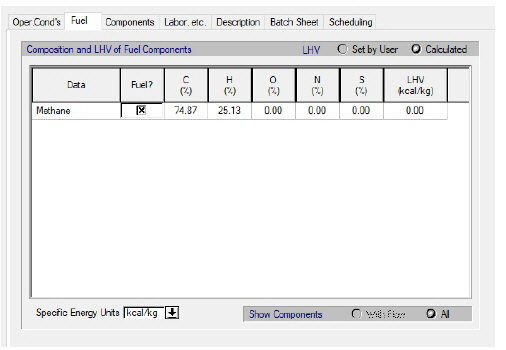

This tab appears on the interface dialog of the following operations:
● Continuous Stoichiometric Reaction in a Rotary Kiln
● Power Generation in a Gas Turbine-Generator
● Power Generation in an IC Engine-Generator
The following table shows a brief description of the variables appearing in this tab. The table also displays their default values and their generally acceptable range.
|
Variable |
Default Value |
Range |
|
|
||
|
○ Is Fuel? |
No |
Yes/No |
|
○ C (%) |
0.0 |
0-100 |
|
○ H (%) |
0.0 |
0-100 |
|
○ O (%) |
0.0 |
0-100 |
|
○ N (%) |
0.0 |
0-100 |
|
○ S (%) |
0.0 |
0-100 |
|
○ LHV (kcal/kg) |
0.0 |
Positive |
Symbol Key: ○ User-specified value (always input); ● Calculated value (always output); ◙ Sometimes input, sometimes output
The following list describes the available specification choices in this tab; for more details on how these are implemented, see the corresponding operation’s Modeling Calculations section:
● Continuous Stoichiometric Reaction in a Rotary Kiln: Modeling Calculations
● Power Generation in a Gas Turbine-Generator: Modeling Calculations
● Power Generation in an IC Engine-Generator: Modeling Calculations
•Composition of Fuel Components...
For each pure component of the fuel stream that is used as fuel, you must first check the “Fuel?” option next to that component and then specify its elemental composition. Note that for a few common fuels, such as methane, hydrogen, ethane, propane, and butane, the elemental composition is calculated by the program automatically as soon as you check the “Fuel?” option, but you can still overwrite the calculated percentages.
•LHV of Fuel Components...
The LHV values of all pure components may be either set by the user or calculated by the program. By default, the LHV of each pure component is calculated automatically by the program every time its composition is updated and the total composition is exactly 100%. The calculation of LHV is based on the elemental combustion reactions for C, H and S, and the standard enthalpies of formation of the pure components that participate in these reactions either as reactants or products.